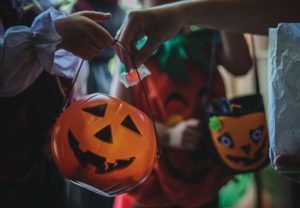AMONG the numerous holiday celebrations worldwide, Halloween takes a remarkable spot in the roster… contending with Christmas, New Year, Valentine’s Day, Mother’s Day, Easter, and Thanksgiving Day while taking a notable third spot in America. It is irrefutably considered to be exciting while stirringly electrifying because of the bevy of colorful costumes and inimitable accessories to choose from: Disney character, super heroes, assorted facsimiles of creatures from the animal kingdom, atrocious images drawn from the wildest imaginations from beneath the darkest crypts and harshest abysses like witches, werewolves, vampires, zombies, and black fairies, and almost anything and everything conceivable and imaginable.
The observance of Halloween was generally thought of as an introductory occurrence to All Saints Day and All Souls Day but a great number of observers are unknowledgeable about the origin and real essence of the occasion.
Its etymology was believed to be coined about 1745 and is of Christian origin from the word “Hallowe’en” which means “Saint’s evening.” It was derived from a Scottish term for “All Hallows’ Eve” and celebrated in a number of countries on the 31st of October, the eve of the Western Christian Feast of all Hallows’ Day which begins the three-day observance of Allhallowtide… the time in the liturgical year dedicated to remembering the dead, including the saints (hallows), martyrs, and the all the faithful departed.

It is widely believed that many Halloween traditions originated from ancient Celtic harvest festivals, particularly the Gaelic festival Samhain; that such festivals may have had pagan roots; and that Samhain itself was Christianized as Halloween by the early Church. Some believe, however, that Halloween began solely as a Christian holiday, separate from ancient festivals like Samhain, a Gaelic festival marking the end of the harvest season and the beginning of winter or the “darker half” of the year

Samhain (pronounced ‘sow’inn’) is a very important date in the Pagan calendar for it marks the Feast of the Dead. Many Pagans or Celtic people also celebrate it as the old Celtic New Year over 2,000 years ago while simultaneously being celebrated by non-Pagans who call this festival Halloween.
No Druid god was more powerful, nor more feared, than Lord Samhain. The roots of Halloween are traced back to the Druid religion and Lord Samhain. Certainly, Halloween took aspects of darkness, black color, evil spirits, and people rising from the dead and roaming the earth on this night
Halloween activities include trick-or-treating (or the related guising), attending Halloween costume parties, carving pumpkins into jack-o’-lanterns, lighting bonfires, apple bobbing, divination games, playing pranks, visiting haunted attractions, telling scary stories, and watching horror films. In many parts of the world, the Christian religious observances of All Hallows’ Eve, including attending church services and lighting candles on the graves of the dead, remain popular, although elsewhere it is a more commercial and secular celebration. Some Christians historically abstained from meat on All Hallows’ Eve, a tradition reflected in the eating of certain vegetarian foods on this vigil day, including apples, potato pancakes, and soul cakes.

Although the Bible does not mention Halloween however, both the ancient origins of Halloween and its modern customs show it to be a celebration based on false beliefs about the dead and invisible spirits, or demons. The Bible warns: “There must never be anyone among you who consults ghosts or spirits or calls up the dead.” (Deuteronomy 18:10-12, The Jerusalem Bible) While some view Halloween as harmless fun, the Bible indicates that the practices associated with it are not.
Halloween costumes, candy, and trick or treat:

According to the book Halloween — An American Holiday, An American History, some of the Celts wore ghoulish costumes so that wandering spirits would mistake them for one of their own and leave them alone. Others offered sweets to the spirits to appease them. In medieval Europe, the Catholic clergy adopted local pagan customs and had their adherents go from house to house wearing costumes and requesting small gifts. Over time, in the United States, the costume selection extended to include popular characters from fiction, celebrities, and generic archetypes such as ninjas and princesses. The Bible, on the other hand, does not permit merging false religious practices with the worship of God.
Ghosts, vampires, werewolves, witches, and zombies had been long been associated with the evil spirit world but the Bible clearly states that we should oppose wicked spirit forces, not celebrate with them.
Halloween pumpkins or jack o’lanterns
In medieval Britain, “supplicants moved from door to door asking for food in return for a prayer for the dead,” and they would carry “hollowed-out turnip lanterns, whose candle connoted a soul trapped in purgatory.” Others say that the lanterns were used to ward off evil spirits. During the 1800s in North America, pumpkins replaced turnips because they were plentiful as well as easy to hollow out and carve. The beliefs and myths behind this custom—the immortality of the soul, purgatory, and prayers for the dead—are not based on the Bible, religious authorities said.
Celebrations like Halloween are in conflict with Bible teachings. The Bible warns: “There must never be anyone among you who practices divination, who is soothsayer, augur or sorcerer, who uses charms, consults ghosts or spirits, or calls up the dead.”
In view of the foregoing, it is wise for you to know about the dark origins of Halloween and similar celebrations. Having this fuller understanding may move you to join many others who do not participate in these holidays
There are other festivities that are like Halloween in that they celebrate the existence and activity of spirit creatures like some of the popular holidays like Halloween around the globe such as the “Day of the Dead” in North America and Europe; “Kawsasqanchis” in South America; “Dance of the Hooded Egunguns,” (a family celebrated masquerade festival) in Africa; and the “Bon or Obon Festival” in Japan which is celebrated either end of July or early August.
But where did candies for Halloween originate? It was believed that the ancient Celts tried to appease wicked spirits with sweets then the church later encouraged celebrants to go from house to house on All Hallows’ Eve to ask for sweets or food in return for a prayer for the dead. This custom eventually became Halloween’s trick or treat.
Most popular Halloween candies and foods for Halloween
Since sweets were believed to appease diabolical spirits candy production became a lucrative business specially during the Halloween season. Now, if you want your house, particularly your doors and windows, to be spared from paints and eggs, offer trick or treaters the following favorite candy brands: Reese’s Peanut Butter Cups, Snickers, Twix, Kit Kat, M&Ms, Nerds, Butterfinger, Sour Patch Kids, Skittles, Hershey bar, and Choco-Kisses.
Dinner tables are expected to be laden with a wide variety of food for the family to share which include caramel apples, caramel corn, Halloween cake, novelty candy shaped like skulls, pumpkins, bats, worms, etc., roasted pumpkin seeds, roasted sweet corn, and a lot more with the addition of colcannon (Ireland), barmbrack (Ireland), bonfire toffee (Great Britain), candy apples/toffee apples (Great Britain and Ireland), candy apples, candy corn, candy pumpkins (North America), and monkey nuts (peanuts in their shells) (Ireland and Scotland).
No matter what and how one observes Halloween, All Saints Day, and All Souls Day, our prayers and wholehearted commemoration of our departed loved ones are what truly count. We should not forget that they just went ahead of us and whether we like it or not, we, too, shall have to go.
Here’s a quote for our dearly departed: “No farewell words were spoken, No time to say good-bye. You were gone before we knew it, And only God knows why. Our hearts still ache in sadness And secret tears still flow, What it meant to lose you, No one will ever know.
_
(Additional contents researched from History.com)
For comments and suggestions, please email to: [email protected].







